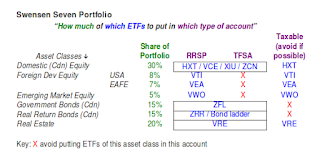The Portfolio
Swensen lists only six asset classes but we have sub-divided foreign equity into USA and the rest of the developed world economies (Europe, Asia, Far East - EAFE) in order to find convenient and low-Management Expense Ratio (MER) ETFs.
An investor with $20,000 to invest in total would thus buy 30% x $20k or $6,000 of any one of four low cost broad market ETFs - HXT, VCE, XIU or ZCN - that will produce more or less equivalent performance (see our previous post comparing these ETFs). Note that the portfolio share is in Canadian dollars. We would need to calculate the US dollar exchange to know how much to buy of the US dollar-traded ETFs VTI, VEA and VWO.
Note that in the real return bonds class, it is quite possible, once you have $5,000 (the typical minimum for a bond purchase at discount brokers) or more to allocate to that class, to buy individual bonds. The Canada maturities are staggered in 5 year maturity increments (see Finiki.org for details). Six bonds build a complete ladder with maturities from 2012 to 2044.
(click on image to enlarge)
The ETFs Below are details of the ETFs and their respective MERs along with the average portfolio MER weighted by the share of the total portfolio, an outstandingly low MER of 0.18% per year. Low costs are key to the investor retaining as much as possible of the long term market returns.
(click on image to enlarge)
The Principles behind the portfolioReaders will have to get hold of the book to get the complete explanation, which is well worth doing as Swensen writes in readable common sense language, but here are some key drivers for the portfolio:
Asset classes must meet certain criteria
- Basic, valuable, differentiable characteristics - substantial expected returns, rising with inflation, protection against financial crises
- Return based on the market, not active management, not market timing, not security selection, which is why all the ETFs above are broad market and cap-weighted
- Wide, deep investable markets to ensure long term liquidity and low cost investment action
(click on image to enlarge)
No asset class dominates and all are large enough to influence overall results
Note that in total the growth equity portions add up to 50% as do the protective fixed income and real estate classes. Similarly, there is a hefty total of inflation-protection assets and financial crisis protection assets. Foreign equities also provide valuable diversification through exposure to currency. Within limits, rather than being an unwanted risk to be removed by hedging, currency exposure is useful, which is why we have avoided all hedged ETFs. Swensen says this and we have noted currency benefits too e.g. A Falling Canadian Dollar Can be an Investor's Friend and The Historical Effect of Currency and Inflation on a Canadian Investor's International Portfolio.
Pre-retirement savings phase means long term orientation - That in turn pushes the portfolio as follows:
- Substantial equity holdings since there are decades ahead to wait through market bubbles and crashes, recessions, wars, spendthrift governments etc and since equity is what will provide the growth
- Long dated federal bond fund (ZFL has an average bond term of 21 years and a duration of 14 years) instead of a short- or mid-duration fund. Despite the high likelihood that interest rates will certainly rise and hurt bond prices when then do, that is not a problem for the investor whose time horizon (time to remain invested before spending the money) is as long as the duration as we explained in this post on interest rates and bond ETFs.
Income tax-minimization dictates preference for RRSP and TFSA and the account placement of certain ETFs
- Tax-deferred (RRSP) and tax-exempt (TFSA) accounts are the first choice for all investments over a taxable account, as we explained in this post; the choice between RRSP and TFSA depends on a number of factors related to the investor's income, which we examined in this post
- Bonds should go in tax-preferred accounts (this post says why)
- Foreign equity ETFs should not go into a TFSA due to withholding taxes as we wrote about here
Every day markets rise and fall and the different asset classes will rise or fall out of sync with each other. Swensen emphasizes the importance of buying or selling portions of holdings to keep the asset classes at the intended target allocations. While the enormous Yale endowment fund has the time and resources to do this daily apparently, he does not recommend a specific strategy for the individual investor, so here we have had to fill in.
Rebalancing rule - The rule we are proposing is a trade-off between trading costs, investor time and effort and maintaining the risk balance, which is the main aim of rebalancing. First, new money contributed to the account should go to the asset class furthest from its target. Second, an annual review and rebalance date should be set to make a set of trades to rebalance. We have written more on this topic in Portfolio Rebalancing - What, Why and How.
Seven is supposed to be a lucky number but the Swensen Seven portfolio is designed to be better than random and put the odds of luck on your side through a well thought out structure from a highly successful investor.
Disclaimer: this post is my opinion only and should not be construed as investment advice. Readers should be aware that the above comparisons are not an investment recommendation. They rest on other sources, whose accuracy is not guaranteed and the article may not interpret such results correctly. Do your homework before making any decisions and consider consulting a professional advisor.




No comments:
Post a Comment